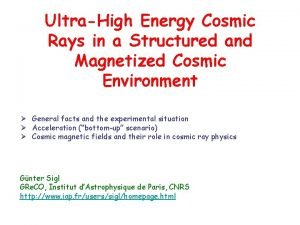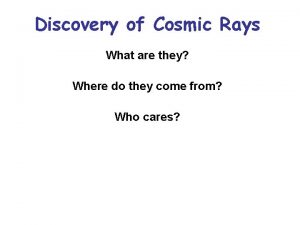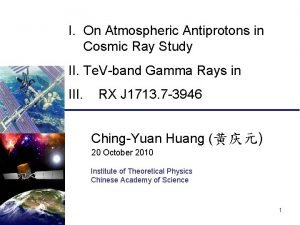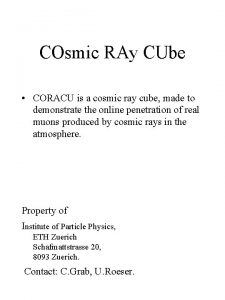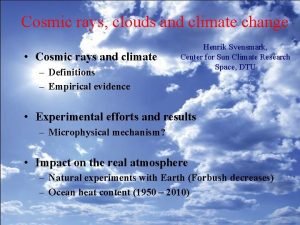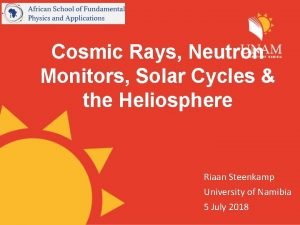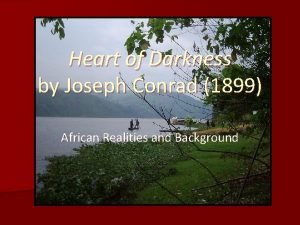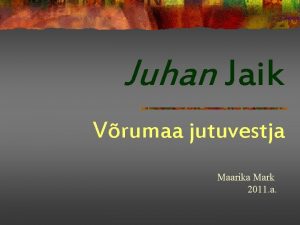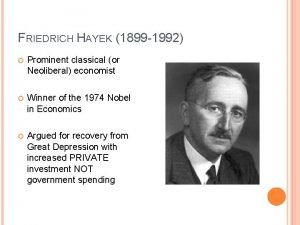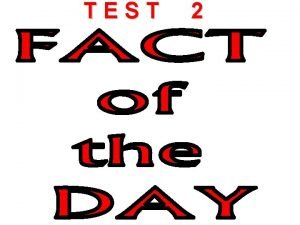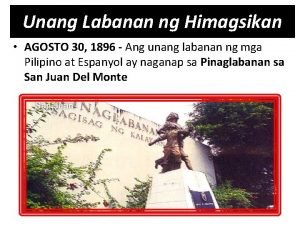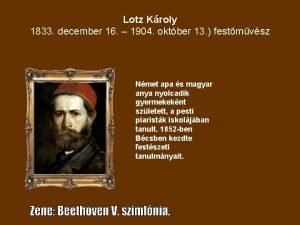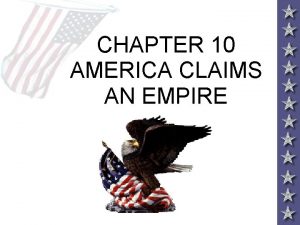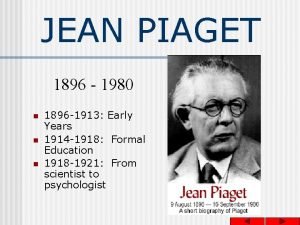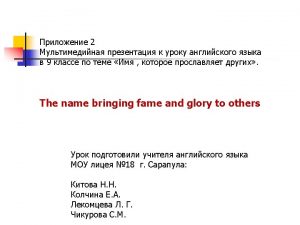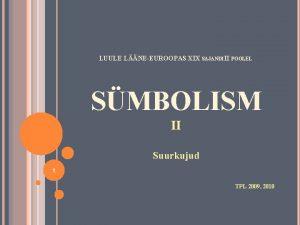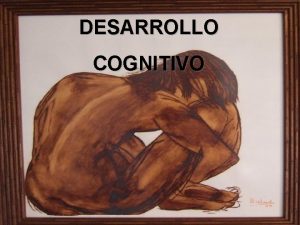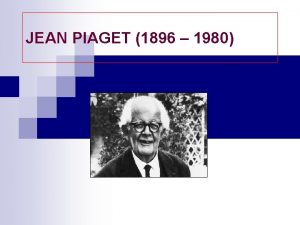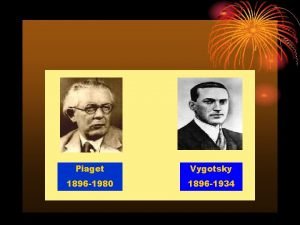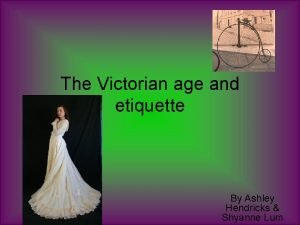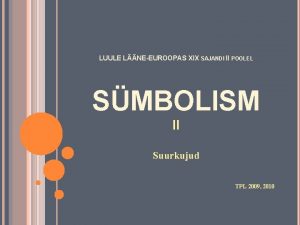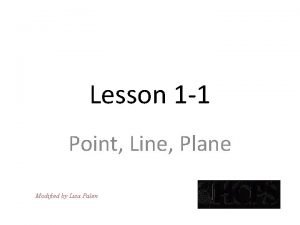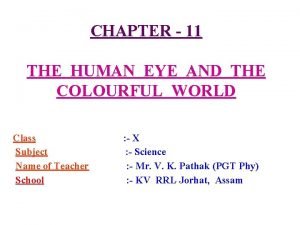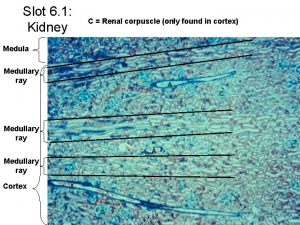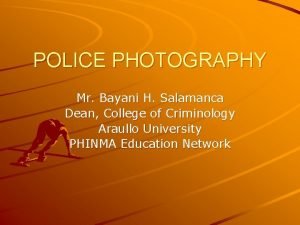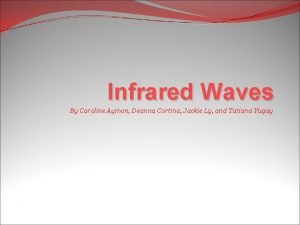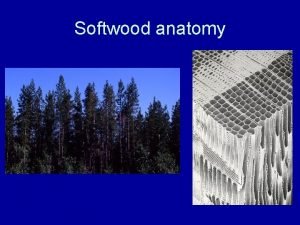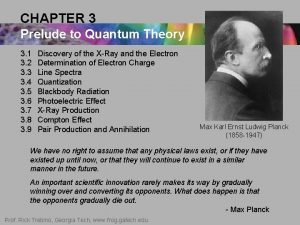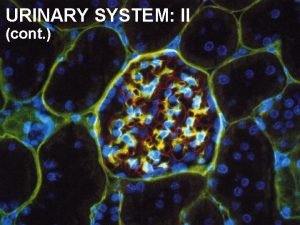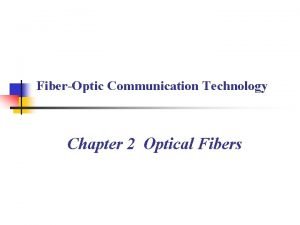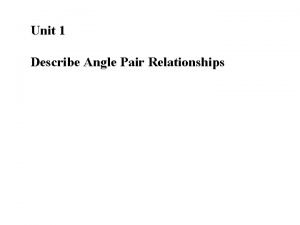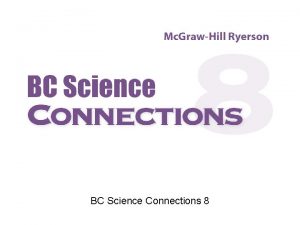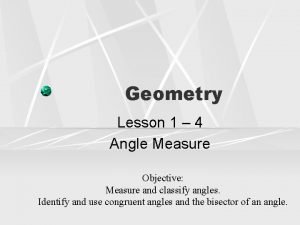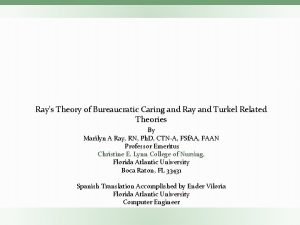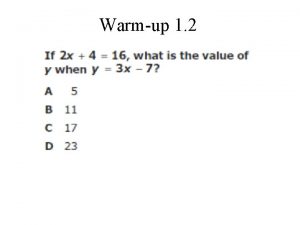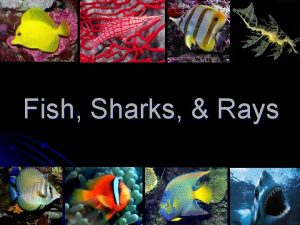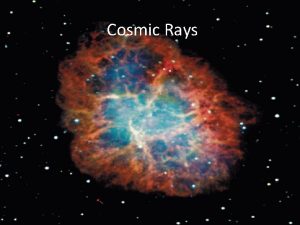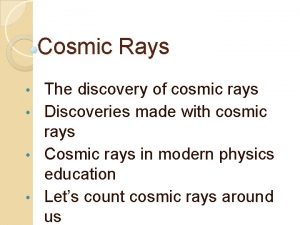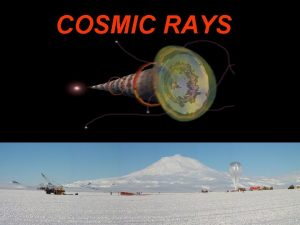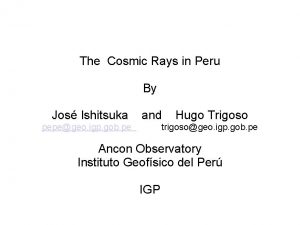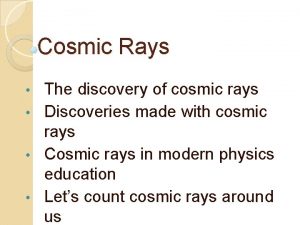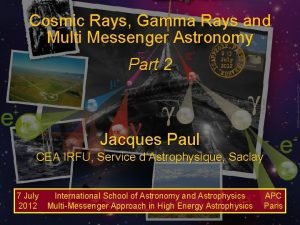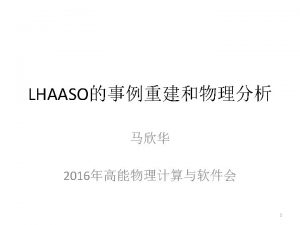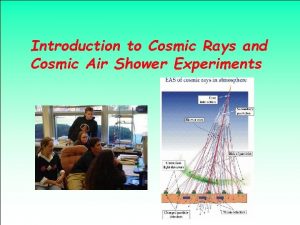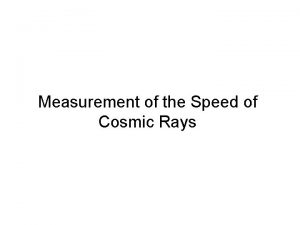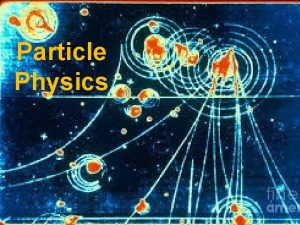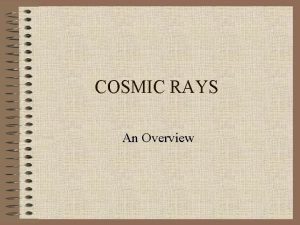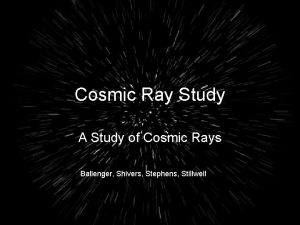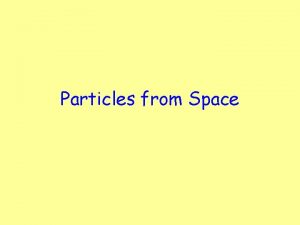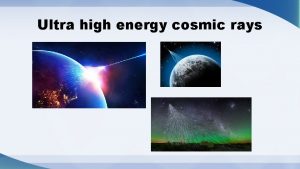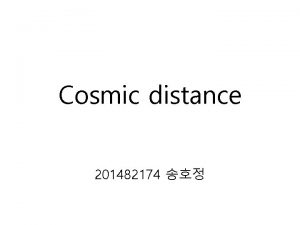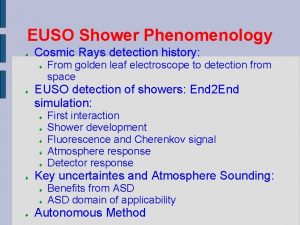A History of Cosmic Rays 1896 1899 a



























































- Slides: 59

A History of Cosmic Rays 1896 1899 a, b g 1912 The Cosmic Ray Observatory Project High Energy Physics Group The University of Nebraska-Lincoln

A History of Cosmic Rays The Cosmic Ray Observatory Project High Energy Physics Group The University of Nebraska-Lincoln

A History of Cosmic Rays The Fantastic Four ® © 1996 Marvel Comics The Cosmic Ray Observatory Project High Energy Physics Group The University of Nebraska-Lincoln

A History of Cosmic Rays The Cosmic Ray Observatory Project High Energy Physics Group The University of Nebraska-Lincoln

A History of Cosmic Rays The Cosmic Ray Observatory Project High Energy Physics Group The University of Nebraska-Lincoln

A History of Cosmic Rays The Cosmic Ray Observatory Project High Energy Physics Group The University of Nebraska-Lincoln

A History of Cosmic Rays The Cosmic Ray Observatory Project High Energy Physics Group The University of Nebraska-Lincoln

A History of Cosmic Rays 1900 Charles T. R. Wilson’s ionization chamber Electroscopes eventually discharge even when all known causes are removed, i. e. , even when electroscopes are • sealed airtight • flushed with dry, dust-free filtered air • far removed from any radioactive samples • shielded with 2 inches of lead! seemed to indicate an unknown radiation with greater penetrability than x-rays or radioactive rays Speculating they might be extraterrestrial, Wilson ran underground tests at night in the Scottish railway, but observed no change in the discharging rate. The Cosmic Ray Observatory Project High Energy Physics Group The University of Nebraska-Lincoln

A History of Cosmic Rays 1909 Jesuit priest, Father Thomas Wulf , improved the ionization chamber with a design planned specifically for high altitude balloon flights. A taut wire pair replaced the gold leaf. This basic design became the pocket dosimeter carried to record one’s total exposure to ionizing radiation. 0 The Cosmic Ray Observatory Project High Energy Physics Group The University of Nebraska-Lincoln

A History of Cosmic Rays 1909 Taking his ionization chamber first to the top of the Eiffel Tower (275 m) Wulf observed a 64% drop in the discharge rate. Familiar with the penetrability of radioactive rays, Wulf expected any ionizing effects due to natural radiation from the ground, would have been heavily absorbed by the “shielding” layers of air. The Cosmic Ray Observatory Project High Energy Physics Group The University of Nebraska-Lincoln

A History of Cosmic Rays Henri Becquerel (1852 -1908) received the 1903 Nobel Prize in Physics for the discovery of natural radioactivity. Wrapped photographic plate showed clear silhouettes, when developed, of the uranium salt samples stored atop it. 1896 While studying the photographic images of various fluorescent and phosphorescent materials, Becquerel finds potassium-uranyl sulfate spontaneously emits radiation capable of penetrating • thick opaque black paper • aluminum plates • copper plates Exhibited by all known compounds of uranium (phosphorescent or not) and metallic uranium itself. The Cosmic Ray Observatory Project High Energy Physics Group The University of Nebraska-Lincoln

A History of Cosmic Rays 1898 Marie Curie discovers thorium (90 Th) Together Pierre and Marie Curie discover polonium (84 Po) and radium (88 Ra) 1899 Ernest Rutherford identifies 2 distinct kinds of rays emitted by uranium: - highly ionizing, but completely absorbed by 0. 006 cm aluminum foil or a few cm of air - less ionizing, but penetrate many meters of air or up to a cm of aluminum. 1900 P. Villard finds in addition to rays, radium emits - the least ionizing, but capable of penetrating many cm of lead, several feet of concrete The Cosmic Ray Observatory Project High Energy Physics Group The University of Nebraska-Lincoln

A History of Cosmic Rays The Cosmic Ray Observatory Project High Energy Physics Group The University of Nebraska-Lincoln

A History of Cosmic Rays Magnetic force is related to q, v and B + The Cosmic Ray Observatory Project High Energy Physics Group The University of Nebraska-Lincoln

A History of Cosmic Rays Lorentz Law Experimental observations: • force depends on direction of v relative to B • if v is parallel to B F = 0 • if v is perpendicular to B F = Fmax • if v is at angle q from B F = Fmax sinq F = q v B sinq The Cosmic Ray Observatory Project High Energy Physics Group The University of Nebraska-Lincoln

A History of Cosmic Rays Direction of Magnetic Force Drawing vectors in tail head out of in to page Direction of magnetic force is “sideways” • force is perpendicular to both v and B • use “right-hand” or “left-hand rule” to find its direction F = q v B sinq The Cosmic Ray Observatory Project High Energy Physics Group The University of Nebraska-Lincoln

A History of Cosmic Rays Right Hand Rule Examples B x x x v x x x F +q B v +q F=0 B ® ® ® v ® ® ® ´ +q F The Cosmic Ray Observatory Project High Energy Physics Group The University of Nebraska-Lincoln

A History of Cosmic Rays In what direction is this positive charge deflected? + A. Left C. Up The Cosmic Ray Observatory Project B. Right D. Down High Energy Physics Group The University of Nebraska-Lincoln

A History of Cosmic Rays A negatively charged beam enters a magnetic field region as shown. What is the direction of B? y z A + y (up) x B – y (down) C + x (right) D + z (out of page) E – z (into page) The Cosmic Ray Observatory Project High Energy Physics Group The University of Nebraska-Lincoln

A History of Cosmic Rays The Cosmic Ray Observatory Project High Energy Physics Group The University of Nebraska-Lincoln

A History of Cosmic Rays The Cosmic Ray Observatory Project High Energy Physics Group The University of Nebraska-Lincoln

A History of Cosmic Rays B-field points into page From these observations alone, what definite conclusions can be made? A. s are positively charged, s negative. B. s are negatively charged, s positive. C. can only say , oppositely charged. The Cosmic Ray Observatory Project High Energy Physics Group The University of Nebraska-Lincoln

A History of Cosmic Rays B field out of page B X Y Z Particles A and B have the same charge, but particle B has more mass. When particle A enters the magnetic field, it travels along line Y. When particle B enters the magnetic field, it will follow line A) X B) Y C) Z The Cosmic Ray Observatory Project High Energy Physics Group The University of Nebraska-Lincoln

A History of Cosmic Rays Centripetal force: 2 F= F The Cosmic Ray Observatory Project High Energy Physics Group The University of Nebraska-Lincoln

A History of Cosmic Rays The Cosmic Ray Observatory Project High Energy Physics Group The University of Nebraska-Lincoln

A History of Cosmic Rays The Cosmic Ray Observatory Project High Energy Physics Group The University of Nebraska-Lincoln

A History of Cosmic Rays 1900 -01 Studying the deflection of these rays in magnetic fields, Becquerel and the Curies establish rays to be charged particles Using the procedure developed by J. J. Thomson in 1887 Becquerel determined the ratio of charge q to mass m for : q/m = 1. 76× 1011 coulombs/kilogram identical to the electron! : q/m = 4. 8× 107 coulombs/kilogram 4000 times smaller! The Cosmic Ray Observatory Project High Energy Physics Group The University of Nebraska-Lincoln

A History of Cosmic Rays 1900 -01 Noting helium gas often found trapped in samples of radioactive minerals, Rutherford speculated that particles might be doubly ionized Helium atoms (He++) 1906 -1909 Rutherford and T. D. Royds develop their “alpha mousetrap” to collect alpha particles and show this yields a gas with the spectral emission lines of helium! Discharge Tube Thin-walled (0. 01 mm) glass tube to vacuum pump & Mercury supply Radium The Cosmic Ray Observatory Project or. High Energy Physics Group Radon gas The University of Nebraska-Lincoln

A History of Cosmic Rays s are ionized Helium (bare Helium nuclei) 2 -protons, 2 -neutrons (positively charged) s are simply electrons(negatively charged) q = -2 q ma=7296 mb The Cosmic Ray Observatory Project High Energy Physics Group The University of Nebraska-Lincoln

A History of Cosmic Rays 1911 -12 Austrian physicist Victor Hess, of the Vienna University, and 2 assistants, carried Wulf ionization chambers up in a series of hydrogen balloon flights. • taking ~hour long readings at several altitudes • both ascending and descending • radiation more intense above 150 meters than at sea level • intensity doubled between 1000 m to 4000 m • increased continuously through 5000 meters Dubbed this “high” level radiation Höhenstrahlung Hess lands following a historic 5, 300 meter flight. August 7, 1912 National Geographic photograph The 1936, Cosmic Ray Observatory Project High Energy Groupprize Thefor University In Hess was awarded the. Physics Nobel thisof Nebraska-Lincoln discovery.

A History of Cosmic Rays Cosmic ray strikes a nucleus within a layer of photographic emulsion The Cosmic Ray Observatory Project High Energy Physics Group 50 m The University of Nebraska-Lincoln

A History of Cosmic Rays 1913 -14 Werner Kolhörster of Berlin’s Physikalisch-Technische Reichsanstalt • ascends to 9300 m (height of Mount Everest, cruising altitude of a passenger jet!) • ionization rate 50× that at sea level! 1925 -26 Robert Millikan of Caltech (winner of the 1923 Nobel prize) initially fails to duplicate such results • over San Antonio, Texas, found “not more than 25% of that found by European observers. ” Further high-altitude measurements made in collaboration with Ira S. Bowen confirmed the existence of what Millikan coined “cosmic rays”. The Cosmic Ray Observatory Project High Energy Physics Group The University of Nebraska-Lincoln

A History of Cosmic Rays 1911 Rutherford’s assistant Hans Geiger develops a device registering the passage of ionizing particles. 1924 Walter Bothe and Geiger use multiple Geiger counters to establish the tracks followed by electron beams 1928 -29 Bothe and Werner Kolhörster build Geiger telescopes and announce cosmic “rays” contain charged particles The Cosmic Ray Observatory Project High Energy Physics Group The University of Nebraska-Lincoln

A History of Cosmic Rays 1927 -28 Jacob Clay from Genoa to the Dutch colony of Java • ionization intensity drops ~6% • minimum at magnetic equator 1929 Bothe & Kolhörster • suggest Clay’s Lattitude Effect was due to • deflection by earth’s magnetic field • primaries are charged The Cosmic Ray Observatory Project High Energy Physics Group The University of Nebraska-Lincoln

A History of Cosmic Rays • inspired by the Norwegian mathematician Carl Størmer’s calculations explaining colleague Kristian Birkland’s theory of the aurora • Birkland experimented with electron beams and a phosphorous-painted globe of lodestone The Cosmic Ray Observatory Project High Energy Physics Group The University of Nebraska-Lincoln

A History of Cosmic Rays The Cosmic Ray Observatory Project High Energy Physics Group The University of Nebraska-Lincoln

A History of Cosmic Rays The Cosmic Ray Observatory Project High Energy Physics Group The University of Nebraska-Lincoln

A History of Cosmic Rays 1930 -33 Arthur Compton (University of Chicago) conducts a worldwide sea- and mountain-level lattitude survey of cosmic ray intensities and confirms the Latitude Effect. The 4 curves correspond to 4 seasons. Physical Review 52 [1937]: p. 808 The Cosmic Ray Observatory Project High Energy Physics Group The University of Nebraska-Lincoln

A History of Cosmic Rays Størmer’s “cutoff energies”: only the fastest cosmics reach sea level near the equator less energetic particles are observable at mid-latitudes unrestricted energies in the polar regions September 21, 1932 Millikan completed a series of tests on the intensity of cosmic rays at various altitudes in a Condor bomber from March Field, California. The Cosmic Ray Observatory Project High Energy Physics Group The University of Nebraska-Lincoln

A History of Cosmic Rays 1933 -35 Thomas Johnson (of the Carnegie Institute) and Bruno Rossi (Italy) independently mount Geiger counter telescope arrays to test for the east-west asymmetry predicted by Georges Lemaître (Belgian) The Cosmic Ray Observatory Project High Energy Physics Group The University of Nebraska-Lincoln

A History of Cosmic Rays Positive charged particles headed toward the earth from space, would tend (at mid-latitudes) to reach the surface coming down from the A. North B. South C. East D. West E. split East and West The Cosmic Ray Observatory Project High Energy Physics Group The University of Nebraska-Lincoln

A History of Cosmic Rays Although cosmic rays do come “from all directions”, at high altitudes near the equator the intensity is higher coming from the West than from the East! 1939 Johnson speculates primaries may be protons! The Cosmic Ray Observatory Project High Energy Physics Group The University of Nebraska-Lincoln

A History of Cosmic Rays Electroscopes become so robust, data can be collected remotely (for example retreived from unmanned weather balloons) The Cosmic Ray Observatory Project High Energy Physics Group The University of Nebraska-Lincoln

A History of Cosmic Rays November 11, 1935 Explorer II, a 113, 000 cubic foot helium balloon ascends to a record 22, 066 m while collecting atmospheric and cosmic ray data. The Cosmic Ray Observatory Project High Energy Physics Group The University of Nebraska-Lincoln

A History of Cosmic Rays 1937 -1939 Studies of Extended Air Showers begin in France when by accident Pierre Auger and his Russian colleague Dimitry Skobeltzyn notice apparent coincidence between Cosmic Ray telescopes set up several hundred meters apart. Cloud chamber photographs by George Rochester and J. G. Wilson of Manchester University showed the large number of particles contained within such showers. The Cosmic Ray Observatory Project High Energy Physics Group The University of Nebraska-Lincoln

A History of Cosmic Rays 1936 Millikan’s group show that at the earth’s surface showers are dominated by electrons, gammas, and X-particles capable of penetrating deep underground (to lake bottom and deep tunnel experiments) characterized there by isolated single cloud chamber tracks The Cosmic Ray Observatory Project High Energy Physics Group The University of Nebraska-Lincoln

A History of Cosmic Rays Definite evidence for the celestial generation of Cosmic Rays came from fortuitous timing of a few high altitude balloon studies during some spectacular solar flares. The Cosmic Ray Observatory Project High Energy Physics Group The University of Nebraska-Lincoln

A History of Cosmic Rays Unusual increase in Cosmic ray intensity associated with an intense solar flare observed February 28, 1942 the same sunspot associated with this flare erupts again March 7, 1942 Similarly the June 4, 1946 solar prominence is followed by another eruption July 25, 1946 and the solar flare event of November 19, 1949 is also captured by airborne cosmic ray instruments each accompanied by a Sudden Ionospheric Disturbance which interrupts radio communications on earth The Cosmic Ray Observatory Project High Energy Physics Group The University of Nebraska-Lincoln

A History of Cosmic Rays During the June 1946 prominence, ultraviolet radiation and x-rays arrived A. shortly before B. simultaneous to C. shortly after the visual observation of the flare. Why? The Cosmic Ray Observatory Project High Energy Physics Group The University of Nebraska-Lincoln

A History of Cosmic Rays During the June 1946 prominence, charged particles causing radio blackouts arrived A. hours before B. minutes before C. simultaneous to D. minutes after E. hours later the visual observation of the flare. Particles causing radio blackouts arrived about 3 hours later. Why? The Cosmic Ray Observatory Project High Energy Physics Group The University of Nebraska-Lincoln

A History of Cosmic Rays Ground-based monitoring stations at low magnetic latitudes observed no increase. Why? However on November 14, 1960 Explorer VII detects solar flares causing “extremely severe” magnetic disturbances in the Earth's atmosphere. The sea level neutron counter at Deep River, Canada records: J. F. Steljes, H. Carmichael, K. Mc. Cracken, Journal of Geophysical Research 66 [1961]: p. 1363 and the National Bureau of Standards measures extensive attenuation of radio transmissions The Cosmic Ray Observatory Project High Energy Physics Group The University of Nebraska-Lincoln

A History of Cosmic Rays May 11, 1950 A Naval Research Viking research rocket fired from the U. S. S. Norton Sound near Jarvis Island in the Pacific collects cosmic ray and pressure and temperature data. 1952 -57 James A. Van Allen (University of Iowa) reports the 1 st high altitude survey of total cosmic-ray intensity and latitude variation of heavy nuclei in primary cosmic radiation, from his “Rockoon” (balloon-launched rocket). February - March, 1958 U. S. Satellites Explorer I and II carry Geiger-Müller counters for Van Allen looping through highly eccentric (50 km perigee, 2600 km apogee) orbits every 2½ hours. Cosmic ray intensities increase steadily with altitude until 2000 km when counters suddenly registered nothing. Lab tests of duplicate counters suggested they had been overloaded by a region with a sudden 15000× increase in cosmic rays! The Cosmic Ray Observatory Project High Energy Physics Group The University of Nebraska-Lincoln

A History of Cosmic Rays 1958 Explorer IV and Sputnik III confirm, what is eventually mapped as 2 gigantic radiation belts of trapped ions. October 13, 1959 Explorer VII was launched. into an Earth orbit. By late December its data reveals • inner belt mostly protons • outer belt mostly electrons The Cosmic Ray Observatory Project High Energy Physics Group The University of Nebraska-Lincoln

A History of Cosmic Rays The Cosmic Ray Observatory Project High Energy Physics Group The University of Nebraska-Lincoln

brief communications A History of Cosmic Rays Space travel Dual origins of light flashes seen in space L ight flashes are unusual visual phenomena that are observed in space and are caused by the interaction of energetic cosmic-ray particles with the human visual system. Using data gathered on board the Mir space station during the Sileye-2 experiment 1 , we show here that there are two separate components of cosmic rays that cause these flashes: one due to heavy nuclei and one due to protons. This indicates that perception by an astronaut’s visual apparatus could involve two complementary mechanisms. Ever since light flashes in space were predicted 2 before the first space mission and subsequently reported by early Apollo astronauts, attempts to determine their cause have been made both in space and using ground-based particle accelerators 3. As a result, several explanations have been proposed to account for the phenomenon ( see ref. 4 and references therein ). The measured rate of occurrence of light flashes (LF) varies for different missions: on Mir 5, it is much lower ( Sileye-1, 0. 18 0. 02 LF min-1; Sileye-2, 0. 13 0. 01 LF min-1) than on Apollo 6 ( 0. 23 0. 1 LF min-1), Skylab 7 ( 1. 3 0. 1 LF min-1) and ASTP 8 (0. 46 0. 05 LF min-1). This effect is probably due chiefly to a reduction in the speed of low-energy particles by Mir’s hull material (aluminium more than 3 mm thick) and the equipment inside the craft. As light flashes are caused by particles interacting with the human visual apparatus, their occurrence should be proportional to particle rate (the so-called ‘latitude effect’). Particle rates outside the region of the South Atlantic Anomaly ( SAA ) depend on the geomagnetic cut-off, which is a function of the position-dependent geomagnetic field intensity and direction. The cut-off C represents the minimum rigidity for cosmic rays to reach Mir’s orbit without being deflected outwards; Figure 1 Rate of occurrence of light flashes on board the Mir space station as a function of particle rate for all particles and for relativistic nuclei inside(circles) and outside(squares) the South Atlantic Anomaly. a, Plot of light-flash rate against proton rate; b, light-flash rate against particle rate for particles with linear-energy transfer of § 20 ke. V mm-1. Linear fits for each region are shown. Data are from the Sileye-2 experiment 1, where astronauts wore light-excluding helmets integrated with cosmic-ray particle-flux detectors, enabling the frequency of flashes to be recorded as a function of background flux & orbit position. it is lower at high geomagnetic latitudes ( for Mir’s orbit, the lowest cut-off is C = 0. 6 gigavolts (GV)) and higher at the geomagnetic equator ( where maximum cut-off is C = 16 GV). The lower the cut-off, the higher the rate of particles coming from outside the Earth’s magnetosphere ( we use the vertical cut-off at each location of Mir). Light-flash and particle rates measured inside Mir were divided in 3 -GV bins that separated the regions outside ( C ≤ 18 GV ) and inside the SAA (3 ≤ C ≤ 15 GV, selected for Earth’s magnetic field B 2. 5 10 -5 tesla; Fig. 1). The light-flash rate, RLF, is plotted against the particle rate, P, for all particles (almost exclusively protons) in Fig. 1 a. In Fig. 1 b, RLF is plotted as a function of the rate of relativistic nuclei, Pn, with charge Z ≥ 6, obtained by selecting particles with high linear-energy transfer ( 20 ke. V m-1) to guarantee the complete removal of the proton component. From the all-particle plot (Fig. 1 a), it is possible to see that RLF is not linearly proportional to proton flux in all regions: in the SAA, it is roughly independent of proton rate ( even though statistical errors preclude any further claim ). For instance, at the centre of the SAA (9≤C≤ 12 GV), where particle Observatory Project High Energy Physics Group University of Nebraska-Lincoln 680 The Cosmic© Ray 2003 Nature Publishing Group NATURE | VOL 422 |The 17 APRIL 2003 | www. nature. com

A History of Cosmic Rays July 31, 1961 NASA funds high-altitude balloon measurements of the proton and alpha-particle spectrum of primary cosmic radiation conducted by the University of Chicago above Uranium City, Saskatchewan, Canada. August 17, 1961 Explorer XII radios data on magnetic fields and cosmic rays from a 54, 000 mile apogee (and 170 mile perigee). 1962 Enroute to Venus Mariner II detects a continuously flowing solar wind of fast and slow streams, cycling in 27 day intervals (the rotational period of the Sun). July 1969 Apollo 11 astronauts trap cosmic ray particles on exposed aluminum foil, returned to earth for analysis of its elemental and isotopic composition. With no atmosphere or magnetic field of its own, the moon’s surface provides a constant bombardment of particles. The Cosmic Ray Observatory Project High Energy Physics Group The University of Nebraska-Lincoln

A History of Cosmic Rays July 1969 Apollo 11 astronauts trap cosmic ray particles on exposed aluminum foil, returned to earth for analysis of its elemental & isotopic composition. With no atmosphere or magnetic field of its own, the moon’s surface is exposed to a constant barrage of particles. The Cosmic Ray Observatory Project High Energy Physics Group The University of Nebraska-Lincoln

A History of Cosmic Rays March 3, 1972 Pioneer 10 launched -on its flyby mission, studies Jupiter's magnetic field and radiation belts. December 1972 Apollo 17’s lunar surface cosmic ray experiment measured the flux of low energy particles in space (foil detectors brought back to Earth for analysis. October 26, 1973 IMP-8 launched. Continues today measuring cosmic rays, Earth’s magnetic field, and the near-Earth solar wind from a near-circular, 12 -day orbit (half the distance to the moon). October 1975 to the present GOES (Geostationary Orbiting Environmental Satellite) An early warning system which monitors the Sun's surface for flares. 1977 The Voyager 1 and 2 spacecraft are launched. Each will explore acceleration processes of charged particles to cosmic ray energies. The Cosmic Ray Observatory Project High Energy Physics Group The University of Nebraska-Lincoln

A History of Cosmic Rays August 31, 1991 Yohkoh spacecraft launched - Japan/USA/England solar probe - studied high-energy radiation from solar flares. July 1992 SAMPEX (Solar Anomalous and Magnetospheric Particle Explorer) in polar orbit. By sampling interplanetary & magnetospheric particles, contributes to our understanding of nucleosynthesis and the acceleration of charged particles. July 1992 IMAX (Isotope Matter-Antimatter e. Xperiment) balloonborne superconducting magnetic spectrometer measured the galactic cosmic ray abundances of protons, anti-protons, hydrogen, and helium isotopes. August 25, 1997 Advanced Composition Explorer (ACE) was launched! The Cosmic Ray Observatory Project High Energy Physics Group The University of Nebraska-Lincoln
 Cosmic rays
Cosmic rays Cosmic rays discoverer
Cosmic rays discoverer Cosmic rays
Cosmic rays Coracu
Coracu Svensmark
Svensmark Cosmic rays
Cosmic rays English city fight against
English city fight against Themes heart of darkness
Themes heart of darkness Kirjanik 1899-1948
Kirjanik 1899-1948 Friedrich hayek (1899-1992)
Friedrich hayek (1899-1992) Monet 1899 london
Monet 1899 london Horace taylor the verdict september 25 1899
Horace taylor the verdict september 25 1899 Ano ang nangyari noong agosto 30 1896
Ano ang nangyari noong agosto 30 1896 1980-1896
1980-1896 Layunin ng katipunan
Layunin ng katipunan Piaget 1896
Piaget 1896 1980-1896
1980-1896 Mother goose 1896
Mother goose 1896 1980 background
1980 background Fnun
Fnun Vācu ķīmiķis 1829-1896
Vācu ķīmiķis 1829-1896 Election of 1896
Election of 1896 Propaganda movement meaning
Propaganda movement meaning Coordination of secondary circular reactions
Coordination of secondary circular reactions Plessy
Plessy 1896-1833
1896-1833 Prantsuse poeet 1844-1896
Prantsuse poeet 1844-1896 1980-1896
1980-1896 Ginebra 1980
Ginebra 1980 Jean piaget 1896-1980
Jean piaget 1896-1980 1980-1896
1980-1896 Urban america 1865 to 1896
Urban america 1865 to 1896 Jean piaget (1896-1980)
Jean piaget (1896-1980) Vygotsky
Vygotsky 1980-1896
1980-1896 In 1896 arbiters of fashion a specific costume for cycling
In 1896 arbiters of fashion a specific costume for cycling Prantsuse poeet 1844-1896
Prantsuse poeet 1844-1896 Linear pair meaning
Linear pair meaning What is renal lobule
What is renal lobule On entering a glass prism, sun‘s rays are
On entering a glass prism, sun‘s rays are Who discovered x rays
Who discovered x rays Medula rays
Medula rays Sensitized material in photography drawing
Sensitized material in photography drawing Characteristics of infrared
Characteristics of infrared Fusiform rays
Fusiform rays N-rays
N-rays Juxtaglomerular cells vs macula densa
Juxtaglomerular cells vs macula densa Waves frequency chart
Waves frequency chart Hip fracture x rays
Hip fracture x rays Name three lines
Name three lines Otdr
Otdr Tangent rays of the sun
Tangent rays of the sun Rms spectral width
Rms spectral width Name two pairs of supplementary angles
Name two pairs of supplementary angles Cathode rays
Cathode rays And the fat worms waiting on a dawn bright lawn
And the fat worms waiting on a dawn bright lawn How to name an angle in four ways
How to name an angle in four ways What is the theory of bureaucratic caring
What is the theory of bureaucratic caring Lesson 1-3 segments rays parallel lines and planes
Lesson 1-3 segments rays parallel lines and planes Sharks phylum
Sharks phylum
